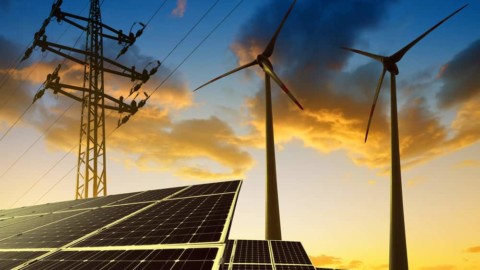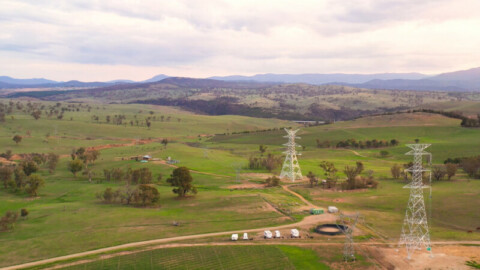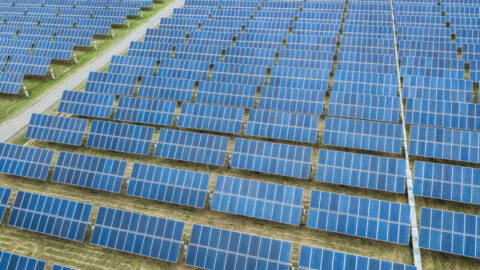By Katie Barnett, Energy Transition Partner, Environmental Deals & Transactions, PwC Australia, and Alex Cocks, Energy Team Associate, PwC
Australia’s path to achieving net zero emissions by 2050 is one paved with both opportunities and challenges for investors. The increasing penetration of variable renewable energy generation is calling for unprecedented levels of dispatchable storage across all generation technologies to ensure reliable delivery of power. Whereas with spinning fleet we can store energy in a coal stockpile, gas linepack, or a hydro reservoir, technology has now advanced to store generated electrons at scale for wind and solar plants.
By 2050, the Australian Energy Market Operator (AEMO) currently forecasts a requirement for more than 30 times the current amount of storage in the National Electricity Market (NEM) or at least 46GW of dispatchable storage (16GW expected to be utility-scale chemical battery and pumped hydro).
At the utility-scale level, this represents in excess of $35 billion of investment.2 What is critical in this deployment is an appropriate mix of long-duration (‘deep’ storage, over 12 hours), medium-duration (between four and 12 hours (inclusive) and short-duration storage (‘shallow’ storage, less than four hours, with one to two hours currently most economic). This 46GW represents an enormous investment opportunity for infrastructure investors.
Whilst energy storage systems can provide a diverse array of power market services over and above mere electron dispatch, a flexible, reliable, diverse and sufficiently deep NEM storage fleet which reinforces system stability is key as the retirement of ageing baseload thermal (coal and gas) generation continues to accelerate.
Currently, economically-viable energy storage comes in two forms; chemical batteries which dominate the broader market in shallow utility-scale and residential storage systems and pumped hydro which currently leads long-duration applications.
Recent years have seen significant reductions to the capital costs for chemical Battery Energy Storage Systems (BESS) and resulted in widespread deployment at greater capacity sizes (from 50MW to 400MW), some with design flexibility to scale to four hours (when it becomes economically viable).
There are a number BESS3 chemistries available with Lithium Iron Phosphate (known as ‘LFP’) currently the most deployed for utility-scale, stationary storage. In the NEM, BESS currently generate revenue through two distinct markets: energy arbitrage and Frequency Control Ancillary Services (FCAS).
The former leverages a battery’s ability to ‘shift’ dispatch through time to take advantage of intra-day patterns in the electricity spot price and effectively mimic a traditional merchant generator by dispatching during periods with favourable/higher pricing (and charging the BESS during periods of lower pricing, thus making a spread).
FCAS utilises a battery’s power-electronic ability to rapidly respond to network dispatch signals to correct frequency imbalances and support system security. Historically, FCAS has been the dominant revenue source for BESS, accounting for around 80 per cent of total battery revenues.
More recently however, the first three quarters5 of last year showed a reversal in this trend with energy comprising 60 per cent of BESS revenues, consistent with significant appreciation in wholesale electricity spot prices and volatility in the market.
Electricity rule makers are expected to continue to incentivise the deployment of technologies capable of providing these services by creating new ancillary service revenue streams such as Fast Frequency Response6 that will further enhance BESS revenue stacks and improve the bankability of battery projects.
That being said, there is a finite requirement in the power market for these services, for example with the current total NEM requirement being relatively small and varying by service, from as little as 215MW for regulation FCAS to over 650MW for some contingency services.
The benefit of BESS
Batteries are highly flexible and can be tailored to suit the operations of different market players and their various revenue models and risk profiles. Differing revenue strategies produce diverse systems that vary in both size (i.e. power) and depth (i.e. storage duration); however, BESS can be split into two broad categories based on whether the system is coupled with generation.
Transmission and distribution businesses – Network Service Providers (NSPs) – typically prefer standalone BESS (that is, BESS directly connected to the grid) at strategic points in their network. Substation connected standalone BESS are also favourable for investors where the BESS is providing firming within the regional reference node.
For NSPs, standalone BESS can create some redundancy in their network availability/performance and NSPs can use the BESS to provide important power-electronic, ancillary system services to keep the network stable. By contrast, proponents of existing large-scale renewable plants (e.g. solar and wind farms) are increasingly integrating utility-scale BESS behind an existing grid connection point – or ‘behind-the-meter’ (BTM).
In doing so, proponents can ‘firm’ (up) their intermittent renewable supply by dispatching the electrons stored in the BESS when the sun isn’t shining or wind isn’t blowing and/or ‘time shift’ the shoulder peaks of the day, while taking advantage of daily variations in the spot price, optimising the revenue of hybrid renewable plants.
The advantages of this BTM approach are the ability to leverage existing plant components (predominantly switchgear), and to seek to optimise network tariff charges through BTM charging (for projects connected to distribution networks). Most prominent however, is the (apparent) avoidance of a timely and costly new grid connection process required to establish a new connection point (a BTM connection can be made under clause 5.3.9 of the National Electricity Rules (NER) (5.3.9).
Although within the spirit of the NER and promising in theory, the time and cost saving merit of a 5.3.9 approach is yet to be seen in the market, with NSPs and AEMO typically undertaking an extensive re-assessment and commissioning of the entire hybrid facility.
This is particularly challenging when in the intervening period extensive changes have occurred with respect to technical requirements in the NER, PSSE or PSCAD models and/or the configuration of, or connections to, the network in proximity to the existing connection point. With this in mind, some Engineering, Procurement & Construction (EPC) contractors are tending to disagree with proponents on mutually, commercially-acceptable, risk allocations.
Understanding the utility-scale generation market
The last five years of NEM activity have highlighted grid connection risk as the most prominent cause of delays and overruns. The grid connection process is a well-known hurdle to new generators achieving full commercial operation.
Among other things, the process defines the Generator Performance Standards (GPS), a set of technical specifications/requirements of how the plant will run, which the generator must uphold once in operation, else receive non-conformance notices. These standards are negotiated with AEMO and the relevant NSP for the purposes of ensuring the connecting equipment does not adversely affect the network.
Depending on the location, new PSCAD and PSSE modelling and other costs associated with a new connection application can cost in the order of $350,000-$500,000 in the period to connection offer. It comes as no surprise that proponents try to avoid a new connection process wherever possible; however, procuring a BTM BESS still requires modifying the connection point and compliance with 5.3.9.
As above, with proponents and EPC contractors at risk of NSPs and AEMO taking a broad interpretation of 5.3.9 and its requirements, mutually acceptable risk allocations can sometimes be difficult. Proponents are typically subject to risk requirements from existing financiers that govern the permissibility of any variation to the existing plant.
Likewise, EPC contractors often act as intermediaries between Original Equipment Manufacturers (OEM) and proponents and lack full control over the equipment (and performance of the existing equipment (e.g. solar or wind components) previously installed behind the connection point) as well as the technical capacity required to manage risk of this nature.
Consequently, EPC contractors will often limit their exposure by only passing through the underlying warranties and performance standards of the BESS OEM. As above, we have observed EPC contractors being generally adverse toward bearing risk relating to the compliance testing and commissioning of the existing wind/solar plant, both on a standalone basis and as a hybrid facility.
More specifically, responsibility for the replacement of the Power Plant Controller and hold point testing are common sticking points that slow or prevent progress. While proponents want EPC contractors to be accountable for adverse outcomes where EPC contractors are necessarily disturbing the existing equipment behind the connection point, EPC contractors do not want to absorb any latent risks intrinsic to the existing plant.
Currently, the elevated state of the BESS procurement market further exacerbates this risk-tolerance gap with a few EPC contractors currently inundated with BESS contracting opportunities and OEMs at manufacturing supply capacity.
This situation coupled with restricted human resources to assess contracting opportunities can lead to EPC contractors favouring ‘easier’ jobs, choosing to not participate in equipment tenders, seeking sole-sourced work with proponents with whom they have previously worked and favouring entirely greenfield hybrid and standalone BESS developments with less complex risk allocations (rather than BTM hybrid retrofits).
Notwithstanding a ‘tight’ contracting market, the sustained stream of development announcements suggests substantial value remains for those that can effectively navigate the environment through various means.
Managing the risk
When it comes to procurement, it is important to recognise the magnitude of any hurdles early on to save on costs and time in negotiating with potential EPC contractors. In doing so, proponents can focus efforts on more suitable parties and identify what options exist to promote reaching a mutually, commercially acceptable position.
More complex projects will experience a more narrowed pool of suitable parties that may reduce the competitive pressure necessary to achieve efficient outcomes in delivery. As such, proponents can benefit by engaging with certain market players that feature favourable structures that promote flexibility.
Those OEMs who also operate in the EPC market boast greater confidence in their technical assessments and solutions, in particular, those who have manufactured the existing components (i.e. the existing wind/solar system) and may be more likely to take on the risk.
Early Contractor Involvement (ECI) packages are another way of de-risking and/or quantifying the risk. A benefit of ECI works is that it can be tailored to address EPC contractor-specific issues and may be carried out before a long-form EPC contract is finalised.
Certain EPC contractors will negotiate ECI packages towards different focuses and to varying extents but generally aim to de-risk obligations relating to GPS acceptance, system strength requirements, reactive compensation and harmonic filter requirements, interface risks and hold point testing.
In doing so, proponents may improve cost certainty; however, achieving a commercially viable position may still be inhibited by other factors such as the existing switchgear. The connection equipment at existing solar/wind farms is not always sufficient to accommodate a BESS of commercially viable size without significant augmentation.
In some cases, the benefit of sharing existing switchgear is not outweighed by the cost of potential delays from modifying the existing connection point and it remains to be fully tested whether BTM hybrid BESS installations provide a material cost and time benefit compared to the onerousness of a new grid connection process.
Due to the relatively low cost of grid interface and connection assets for batteries, some proponents may prefer to establish a new and separate connection point via a side-by-side to the existing wind/solar farm approach. Notwithstanding uncertainty with 5.3.9, this method may yield less complex risk allocations and greater flexibility in operation; however, the impact on timelines remains unproven.
Proponents should therefore exercise caution in determining the connection approach and engage with relevant experts as needed to ensure timely delivery and reduce the likelihood of unforeseen costs.
The opportunity
Australia’s transition to 100 per cent renewable energy by 2050 cannot be achieved without widespread deployment of diverse energy storage systems to ‘firm’ intermittent renewables and provide critical system services in the absence of thermal coal and gas generators.
With this need comes opportunity, with BESS currently representing one of the most accessible ways for market players to take advantage of intraday price movements and tap into evolving markets that protect sovereign energy security.
Proponents of solar/wind farms (both existing and developing) are well positioned to benefit from battery systems if they can effectively navigate the various aspects of procurement to fully realise their promise.
The connection approach requires deliberate planning to understand the complexity of the hybrid system and identify any constraints early in procurement. Proponents can then engage with the parties best suited to manage risks and utilise ECI packages to facilitate greater risk transfer and support a timely project delivery.
In doing so, proponents can capitalise on a 46GW in excess of $35 billion opportunity that complements existing assets, offers diverse revenue stacks and promises long-term returns as renewables contribute a greater amount to Australia’s energy needs.



















